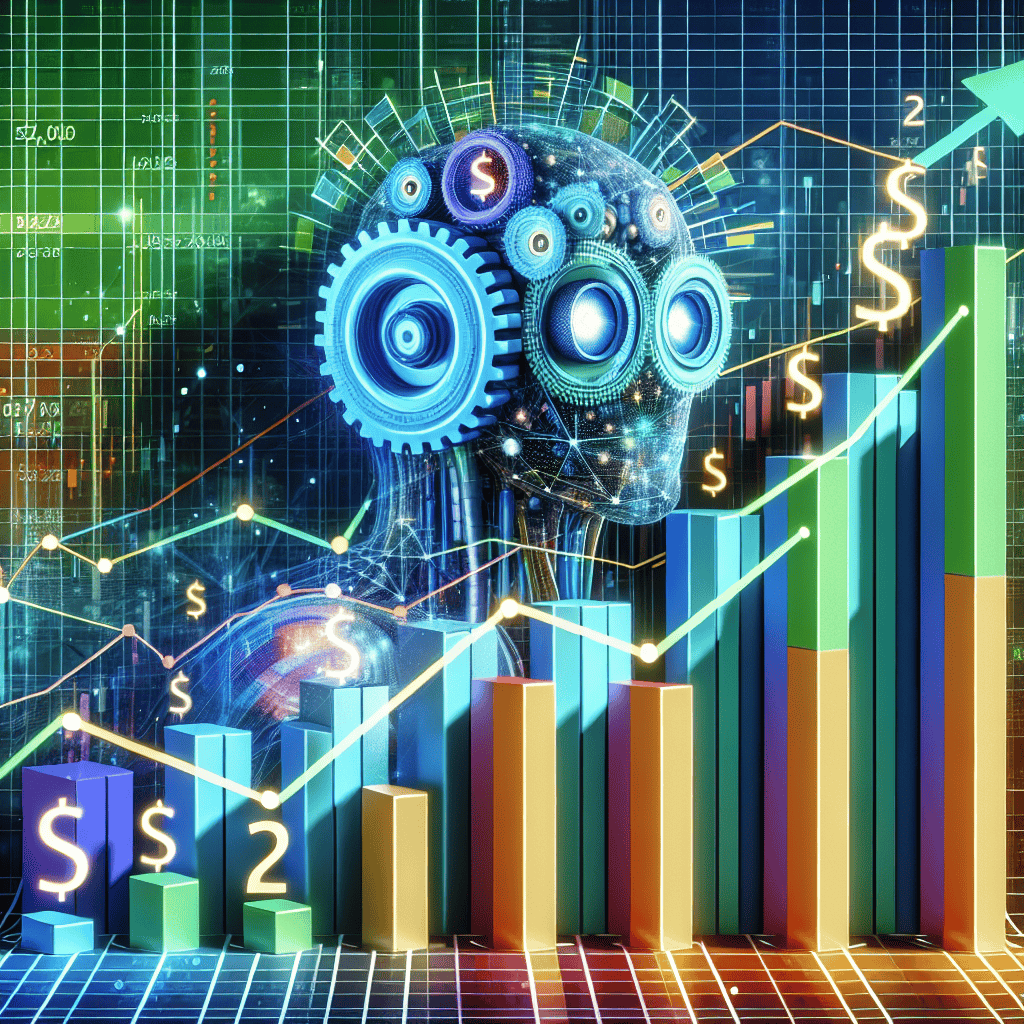“Unleashing Tomorrow: AI-Driven Innovation Fuels a Decade of US Stock Market Dominance.”
Introduction
The integration of artificial intelligence (AI) into the financial sector is poised to redefine the landscape of the US stock market, potentially cementing its leadership for the next decade. As AI technologies continue to evolve, they offer unprecedented capabilities in data analysis, predictive modeling, and automated trading, enabling investors to make more informed decisions with greater speed and accuracy. The adoption of AI-driven tools can enhance market efficiency, reduce transaction costs, and improve risk management, thereby attracting more global capital into US markets. Furthermore, AI’s ability to process vast amounts of information in real-time can lead to more dynamic and responsive market environments, fostering innovation and competitiveness. As US companies increasingly leverage AI to optimize operations and drive growth, the stock market stands to benefit from enhanced corporate performance and investor confidence. This technological revolution not only promises to sustain the US stock market’s dominance but also to transform it into a more resilient and adaptive financial ecosystem.
Impact Of AI On Stock Market Efficiency
The integration of artificial intelligence (AI) into the financial sector is poised to significantly enhance the efficiency of the US stock market, potentially solidifying its leadership on the global stage for the next decade. As AI technologies continue to evolve, they offer unprecedented opportunities to refine market operations, improve decision-making processes, and optimize trading strategies. This transformation is not only reshaping the landscape of financial markets but also setting the stage for a more robust and resilient economic environment.
To begin with, AI’s ability to process vast amounts of data at remarkable speeds is revolutionizing the way market participants analyze information. Traditional methods of data analysis, which often rely on human interpretation and manual processes, are being supplanted by AI-driven algorithms capable of identifying patterns and trends with remarkable accuracy. This shift allows investors to make more informed decisions, reducing the likelihood of errors and enhancing overall market efficiency. Moreover, AI’s predictive capabilities enable market participants to anticipate market movements and adjust their strategies accordingly, thereby minimizing risks and maximizing returns.
In addition to improving data analysis, AI is also transforming trading practices through the development of sophisticated algorithmic trading systems. These systems leverage machine learning techniques to execute trades at optimal times and prices, often outperforming human traders. By automating the trading process, AI reduces the impact of human emotions and biases, which can lead to irrational decision-making and market volatility. Consequently, the increased use of AI in trading is expected to contribute to a more stable and efficient market environment.
Furthermore, AI’s impact extends beyond individual trading strategies to encompass broader market operations. For instance, AI-powered systems are being employed to enhance market surveillance and detect fraudulent activities. By analyzing transaction data in real-time, these systems can identify suspicious patterns and alert regulators to potential market manipulation. This capability not only helps maintain market integrity but also boosts investor confidence, which is crucial for sustaining market leadership.
As AI continues to permeate the financial sector, it is also fostering innovation in financial products and services. The development of AI-driven investment platforms and robo-advisors is democratizing access to sophisticated investment strategies, enabling a wider range of investors to participate in the market. This increased participation can lead to greater liquidity and more efficient price discovery, further enhancing market efficiency.
However, the integration of AI into the stock market is not without challenges. Concerns about data privacy, algorithmic transparency, and the potential for systemic risks must be addressed to ensure the responsible deployment of AI technologies. Policymakers and regulators will need to collaborate with industry stakeholders to establish frameworks that balance innovation with risk management. By doing so, they can create an environment that fosters the sustainable growth of AI-driven market practices.
In conclusion, the impact of AI on stock market efficiency is profound and multifaceted. By enhancing data analysis, optimizing trading strategies, improving market surveillance, and fostering financial innovation, AI has the potential to propel the US stock market to new heights of leadership over the next decade. As the financial sector continues to embrace these technologies, it is imperative that stakeholders work together to navigate the challenges and opportunities that lie ahead, ensuring that the benefits of AI are realized in a manner that promotes long-term market stability and growth.
AI-Driven Investment Strategies
The advent of artificial intelligence (AI) has ushered in a new era of possibilities across various sectors, and the financial markets are no exception. As AI technology continues to evolve, its integration into investment strategies is poised to redefine the landscape of the US stock market, potentially propelling it to new heights of leadership over the next decade. This transformation is not merely speculative; it is grounded in the tangible benefits that AI-driven investment strategies offer, which include enhanced data analysis, improved decision-making, and increased efficiency.
To begin with, AI’s ability to process vast amounts of data at unprecedented speeds is revolutionizing how investors approach the stock market. Traditional investment strategies often rely on historical data and human intuition, which can be limited by cognitive biases and the sheer volume of information available. In contrast, AI algorithms can analyze complex datasets, identify patterns, and generate insights that might elude even the most experienced human analysts. This capability allows investors to make more informed decisions, potentially leading to higher returns and reduced risks.
Moreover, AI-driven investment strategies are characterized by their adaptability and continuous learning. Unlike static models, AI systems can evolve by learning from new data, adjusting their algorithms to reflect changing market conditions. This dynamic approach enables investors to stay ahead of market trends and respond swiftly to emerging opportunities or threats. As a result, AI can help investors optimize their portfolios, balancing risk and reward more effectively than traditional methods.
In addition to enhancing decision-making, AI also contributes to increased efficiency in the investment process. Automated trading systems powered by AI can execute trades at lightning speed, capitalizing on market movements in real-time. This capability not only reduces transaction costs but also minimizes the impact of human error, which can be costly in fast-paced trading environments. Furthermore, AI can streamline back-office operations, such as compliance and reporting, freeing up resources for more strategic activities.
As AI-driven investment strategies gain traction, they are likely to attract significant capital inflows, further solidifying the US stock market’s leadership position. Institutional investors, in particular, are increasingly recognizing the potential of AI to deliver superior returns. By incorporating AI into their investment processes, these investors can enhance their competitive edge, drawing more funds into the US market. This influx of capital can drive innovation and growth, creating a virtuous cycle that reinforces the market’s dominance.
However, the integration of AI into investment strategies is not without challenges. Concerns about data privacy, algorithmic transparency, and ethical considerations must be addressed to ensure that AI is used responsibly. Regulatory frameworks will need to evolve to keep pace with technological advancements, providing oversight while fostering innovation. Additionally, investors must remain vigilant about the limitations of AI, recognizing that it is a tool to augment, not replace, human judgment.
In conclusion, AI-driven investment strategies hold the potential to propel the US stock market to new heights of leadership over the next decade. By enhancing data analysis, improving decision-making, and increasing efficiency, AI can transform how investors approach the market, unlocking new opportunities for growth. While challenges remain, the benefits of AI integration are compelling, offering a glimpse into a future where technology and finance converge to create a more dynamic and resilient market. As the US stock market embraces this transformation, it stands poised to lead the global financial landscape into a new era of innovation and prosperity.
Enhancing Risk Management With AI
In the rapidly evolving landscape of financial markets, the integration of artificial intelligence (AI) into risk management strategies is poised to significantly enhance the United States’ leadership in the global stock market over the next decade. As financial institutions increasingly adopt AI technologies, they are better equipped to navigate the complexities and uncertainties inherent in market dynamics. This technological advancement not only optimizes decision-making processes but also fortifies the resilience of financial systems against potential disruptions.
To begin with, AI’s ability to process vast amounts of data at unprecedented speeds offers a substantial advantage in risk management. Traditional methods of risk assessment often rely on historical data and statistical models, which can be limited in their capacity to predict future market behavior. In contrast, AI algorithms can analyze real-time data from diverse sources, including social media, news outlets, and economic indicators, to identify emerging trends and potential risks. This comprehensive analysis enables financial institutions to anticipate market shifts and adjust their strategies accordingly, thereby minimizing potential losses.
Moreover, AI enhances risk management by improving the accuracy of predictive models. Machine learning, a subset of AI, allows systems to learn from past data and refine their predictions over time. This continuous learning process results in models that are more adept at identifying patterns and correlations that may not be immediately apparent to human analysts. Consequently, financial institutions can develop more robust risk management frameworks that account for a wider range of variables and scenarios. This capability is particularly crucial in an era characterized by rapid technological advancements and geopolitical uncertainties, where traditional risk models may fall short.
In addition to predictive accuracy, AI contributes to more effective risk mitigation through automation. By automating routine tasks such as data collection, analysis, and reporting, AI frees up human resources to focus on more strategic aspects of risk management. This not only enhances operational efficiency but also reduces the likelihood of human error, which can be a significant source of risk in financial operations. Furthermore, AI-driven automation enables real-time monitoring of market conditions, allowing for swift responses to emerging threats and opportunities.
Another critical aspect of AI’s impact on risk management is its role in enhancing cybersecurity. As financial markets become increasingly digital, the threat of cyberattacks poses a significant risk to market stability. AI technologies can bolster cybersecurity measures by detecting and responding to threats more quickly and accurately than traditional methods. For instance, AI systems can identify unusual patterns of behavior that may indicate a cyberattack, enabling institutions to take preventive action before significant damage occurs. This proactive approach to cybersecurity is essential for maintaining investor confidence and ensuring the integrity of financial markets.
Furthermore, the integration of AI into risk management strategies fosters greater transparency and accountability. AI systems can provide detailed insights into the decision-making processes, allowing stakeholders to understand the rationale behind specific actions. This transparency not only builds trust among investors and regulators but also facilitates compliance with increasingly stringent regulatory requirements.
In conclusion, the adoption of AI in risk management is set to play a pivotal role in propelling the US stock market’s leadership over the next decade. By enhancing data analysis, predictive accuracy, operational efficiency, cybersecurity, and transparency, AI equips financial institutions with the tools necessary to navigate an increasingly complex and volatile market environment. As these technologies continue to evolve, they will undoubtedly shape the future of risk management, ensuring that the US stock market remains at the forefront of global financial innovation.
AI And The Future Of Stock Market Predictions

Artificial intelligence (AI) is poised to revolutionize various sectors, and its impact on the stock market is no exception. As we look toward the next decade, AI’s potential to propel US stock market leadership is becoming increasingly apparent. The integration of AI into stock market predictions is not merely a trend but a transformative force that could redefine how investors approach the market. By leveraging vast amounts of data and sophisticated algorithms, AI can offer insights that were previously unimaginable, thus enhancing the accuracy and efficiency of stock market predictions.
To begin with, AI’s ability to process and analyze large datasets at unprecedented speeds is a game-changer for stock market predictions. Traditional methods of analysis, which often rely on historical data and human intuition, are limited by the sheer volume of information available. In contrast, AI can sift through vast amounts of data, including financial reports, news articles, and social media sentiment, to identify patterns and trends that might elude human analysts. This capability allows for more informed decision-making, enabling investors to anticipate market movements with greater precision.
Moreover, AI’s predictive power is not confined to short-term market fluctuations. By employing machine learning algorithms, AI systems can learn from past data to forecast long-term trends, offering investors a strategic advantage. These algorithms can adapt to new information, continuously refining their predictions as market conditions evolve. This adaptability is crucial in a rapidly changing economic landscape, where traditional models may struggle to keep pace.
In addition to enhancing predictive accuracy, AI can also democratize access to sophisticated analytical tools. Historically, advanced market analysis has been the domain of large financial institutions with substantial resources. However, AI-driven platforms are making these tools accessible to a broader range of investors, leveling the playing field. By providing retail investors with the same analytical capabilities as their institutional counterparts, AI can foster a more inclusive investment environment, potentially driving greater participation in the stock market.
Furthermore, AI’s role in risk management cannot be overstated. By identifying potential risks and anomalies in real-time, AI can help investors mitigate losses and optimize their portfolios. This proactive approach to risk management is particularly valuable in volatile markets, where rapid changes can have significant financial implications. As a result, AI-driven risk assessment tools are becoming indispensable for investors seeking to navigate the complexities of the stock market.
However, the integration of AI into stock market predictions is not without challenges. Concerns about data privacy, algorithmic bias, and the potential for over-reliance on technology must be addressed to ensure that AI’s benefits are fully realized. Regulatory frameworks will need to evolve to keep pace with technological advancements, safeguarding the interests of all market participants.
In conclusion, AI holds the promise of propelling US stock market leadership over the next decade by enhancing the accuracy, efficiency, and accessibility of market predictions. As AI continues to evolve, its impact on the stock market will likely grow, offering new opportunities for investors and reshaping the financial landscape. By embracing AI’s potential while addressing its challenges, the US stock market can maintain its competitive edge and continue to lead on the global stage.
AI’s Role In Identifying Market Trends
Artificial intelligence (AI) is increasingly becoming a pivotal force in shaping the future of financial markets, particularly in the United States. As the global economy becomes more interconnected and complex, the ability to swiftly analyze vast amounts of data and identify emerging trends is crucial. AI, with its advanced algorithms and machine learning capabilities, offers a transformative approach to understanding market dynamics, potentially propelling the US stock market to maintain its leadership over the next decade.
To begin with, AI’s ability to process and analyze large datasets far surpasses human capabilities. This is particularly important in the stock market, where the volume of data generated daily is staggering. From stock prices and trading volumes to economic indicators and news articles, the sheer amount of information can be overwhelming. AI systems can sift through this data at lightning speed, identifying patterns and correlations that might elude human analysts. This capability allows investors to make more informed decisions, potentially leading to more profitable outcomes.
Moreover, AI’s predictive analytics can offer insights into future market trends. By analyzing historical data and identifying patterns, AI can forecast potential market movements with a degree of accuracy that was previously unattainable. This predictive power is invaluable for investors seeking to anticipate market shifts and adjust their strategies accordingly. As a result, AI-driven insights can lead to more strategic investment decisions, enhancing the overall efficiency of the market.
In addition to predictive analytics, AI can also enhance risk management strategies. The stock market is inherently volatile, and managing risk is a critical component of successful investing. AI can help identify potential risks by analyzing market conditions and historical data, allowing investors to mitigate potential losses. For instance, AI can detect early warning signs of market downturns, enabling investors to adjust their portfolios proactively. This ability to anticipate and respond to market changes can help stabilize the market and reduce the impact of sudden fluctuations.
Furthermore, AI’s role in identifying market trends extends beyond individual stocks to broader economic indicators. By analyzing macroeconomic data, AI can provide insights into economic trends that may impact the stock market. This includes factors such as interest rates, inflation, and employment figures. By understanding these broader trends, investors can make more informed decisions about their portfolios, potentially leading to more stable and sustainable market growth.
As AI continues to evolve, its applications in the stock market are likely to expand. Innovations such as natural language processing and sentiment analysis are already being used to analyze news articles and social media posts, providing real-time insights into market sentiment. This can help investors gauge public perception and its potential impact on stock prices, further enhancing their ability to make informed decisions.
In conclusion, AI’s role in identifying market trends is poised to be a driving force in maintaining US stock market leadership over the next decade. Its ability to process vast amounts of data, predict future trends, enhance risk management, and analyze broader economic indicators offers a significant advantage in navigating the complexities of the financial markets. As AI technology continues to advance, its impact on the stock market is likely to grow, offering new opportunities for investors and reinforcing the US’s position as a global financial leader.
The Influence Of AI On Trading Volume
The influence of artificial intelligence (AI) on trading volume in the US stock market is poised to be a transformative force over the next decade. As AI technologies continue to evolve, they are increasingly being integrated into various aspects of financial markets, from algorithmic trading to risk management. This integration is expected to significantly impact trading volumes, potentially propelling the US stock market to new heights of leadership on the global stage.
To begin with, AI’s ability to process vast amounts of data at unprecedented speeds is revolutionizing the way trading decisions are made. Traditional methods of analyzing market trends and making investment decisions are being supplemented, and in some cases replaced, by AI-driven algorithms. These algorithms can analyze complex datasets, identify patterns, and execute trades in milliseconds, far surpassing human capabilities. As a result, trading volumes are likely to increase as more market participants adopt AI technologies to gain a competitive edge.
Moreover, AI’s role in enhancing market efficiency cannot be overstated. By reducing the time it takes to analyze information and execute trades, AI contributes to a more efficient market where prices more accurately reflect available information. This increased efficiency can attract more investors, both institutional and retail, leading to higher trading volumes. Additionally, AI can help mitigate risks by providing more accurate forecasts and identifying potential market anomalies before they escalate, further boosting investor confidence and participation.
Furthermore, the democratization of AI tools is another factor that could drive up trading volumes. As AI technologies become more accessible and affordable, a broader range of market participants, including smaller firms and individual investors, can leverage these tools. This democratization allows for a more diverse set of players in the market, each contributing to increased trading activity. The proliferation of AI-driven trading platforms and applications is likely to encourage more frequent trading, as investors can make more informed decisions with the help of AI insights.
In addition to these factors, the integration of AI into trading strategies is fostering innovation in financial products and services. For instance, AI is enabling the development of new financial instruments and investment strategies that were previously unimaginable. These innovations can attract new investors and increase trading volumes as market participants seek to capitalize on novel opportunities. The continuous evolution of AI technologies ensures that the financial markets remain dynamic and adaptive, further solidifying the US stock market’s leadership position.
However, it is important to acknowledge the challenges and risks associated with the increasing influence of AI on trading volumes. The reliance on AI-driven algorithms raises concerns about market stability, particularly in the event of unforeseen algorithmic errors or cyber threats. Regulators and market participants must work collaboratively to establish robust frameworks that ensure the safe and ethical use of AI in financial markets. By addressing these challenges, the potential benefits of AI can be fully realized, paving the way for sustained growth in trading volumes.
In conclusion, the influence of AI on trading volume is set to be a key driver of the US stock market’s leadership over the next decade. Through enhanced data processing capabilities, increased market efficiency, democratization of AI tools, and innovation in financial products, AI is poised to transform the landscape of trading. While challenges remain, the potential for AI to propel trading volumes and reinforce the US stock market’s global leadership is immense, promising a future of unprecedented growth and opportunity.
AI-Powered Financial Analysis And Reporting
Artificial intelligence (AI) is poised to revolutionize the financial sector, particularly in the realm of financial analysis and reporting. As the United States continues to lead in technological innovation, the integration of AI into financial systems could significantly bolster its stock market leadership over the next decade. The transformative potential of AI lies in its ability to process vast amounts of data with unprecedented speed and accuracy, offering insights that were previously unattainable through traditional methods.
To begin with, AI-powered financial analysis can enhance decision-making processes by providing more accurate and timely information. Machine learning algorithms can analyze historical data, identify patterns, and predict future trends with a high degree of precision. This capability allows investors and financial analysts to make informed decisions, reducing the risk of human error and emotional bias. Moreover, AI can process real-time data from various sources, including social media, news outlets, and market reports, to provide a comprehensive view of market conditions. This real-time analysis enables stakeholders to respond swiftly to market changes, thereby maintaining a competitive edge.
In addition to improving decision-making, AI can streamline financial reporting by automating routine tasks. Traditionally, financial reporting has been a labor-intensive process, requiring meticulous attention to detail and significant time investment. However, AI can automate data collection, reconciliation, and report generation, significantly reducing the time and effort required. This automation not only increases efficiency but also enhances accuracy by minimizing the potential for human error. Furthermore, AI can ensure compliance with regulatory requirements by continuously monitoring transactions and flagging any anomalies for further investigation.
As AI continues to evolve, its applications in financial analysis and reporting are expected to expand. For instance, natural language processing (NLP) can be used to analyze qualitative data, such as earnings calls and analyst reports, to gauge market sentiment and predict stock performance. By understanding the nuances of language, AI can provide deeper insights into the factors driving market movements. Additionally, AI can facilitate personalized investment strategies by analyzing individual investor profiles and tailoring recommendations to their specific needs and risk tolerance.
The integration of AI into financial systems also presents opportunities for enhanced risk management. By analyzing historical data and identifying potential risk factors, AI can help financial institutions develop more robust risk management strategies. This proactive approach to risk management can mitigate potential losses and enhance the stability of financial markets. Furthermore, AI can detect fraudulent activities by identifying unusual patterns and behaviors, thereby safeguarding the integrity of financial systems.
While the benefits of AI in financial analysis and reporting are substantial, it is important to acknowledge the challenges associated with its implementation. Data privacy and security concerns must be addressed to ensure the protection of sensitive information. Additionally, the reliance on AI systems necessitates a robust infrastructure and skilled workforce capable of managing and maintaining these technologies. Despite these challenges, the potential of AI to propel US stock market leadership is undeniable.
In conclusion, AI-powered financial analysis and reporting hold the promise of transforming the financial sector, enhancing decision-making, efficiency, and risk management. As the United States continues to lead in AI innovation, its stock market is well-positioned to maintain its leadership over the next decade. By embracing AI technologies, financial institutions can unlock new opportunities for growth and stability, ensuring a prosperous future for the US stock market.
Q&A
1. **Question:** How can AI enhance decision-making in the stock market?
– **Answer:** AI can process vast amounts of data quickly, identify patterns, and provide insights that enhance decision-making, leading to more informed investment strategies.
2. **Question:** What role does AI play in algorithmic trading?
– **Answer:** AI improves algorithmic trading by optimizing trade execution, reducing transaction costs, and increasing the speed and accuracy of trades.
3. **Question:** How might AI contribute to risk management in the stock market?
– **Answer:** AI can predict market volatility and potential risks by analyzing historical data and current market conditions, allowing for better risk management strategies.
4. **Question:** In what ways can AI-driven analytics benefit stock market investors?
– **Answer:** AI-driven analytics can provide investors with real-time insights, trend analysis, and predictive modeling, helping them make more strategic investment decisions.
5. **Question:** How could AI impact the efficiency of financial markets?
– **Answer:** AI can increase market efficiency by improving liquidity, reducing information asymmetry, and enabling faster dissemination of information.
6. **Question:** What potential does AI have for innovation in financial products?
– **Answer:** AI can lead to the creation of new financial products and services, such as personalized investment portfolios and robo-advisors, tailored to individual investor needs.
7. **Question:** How might AI influence the competitive landscape of the US stock market?
– **Answer:** AI could give US markets a competitive edge by fostering innovation, attracting global investments, and maintaining leadership in financial technology advancements.
Conclusion
AI has the potential to significantly propel US stock market leadership over the next decade by driving innovation, enhancing productivity, and creating new market opportunities. As AI technologies continue to evolve, they can lead to more efficient business operations, improved decision-making, and the development of new products and services. This can result in increased competitiveness for US companies on a global scale. Furthermore, AI can enhance financial market operations through better data analysis, risk management, and algorithmic trading, leading to more efficient and liquid markets. The integration of AI across various sectors can also stimulate economic growth, attract investment, and create high-value jobs, further solidifying the US’s position as a leader in the global stock market. However, realizing this potential will require addressing challenges such as ethical considerations, regulatory frameworks, and ensuring equitable access to AI technologies. Overall, with strategic investments and policies, AI could be a key driver of US stock market leadership in the coming decade.





